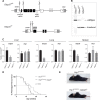Deficiency of the Endocytic Protein Hip1 Leads to Decreased Gdpd3 Expression, Low Phosphocholine, and Kypholordosis
- PMID: 30224518
- PMCID: PMC6234285
- DOI: 10.1128/MCB.00385-18
Deficiency of the Endocytic Protein Hip1 Leads to Decreased Gdpd3 Expression, Low Phosphocholine, and Kypholordosis
Abstract
Deficiency of huntingtin-interacting protein 1 (Hip1) results in degenerative phenotypes. Here we generated a Hip1 deficiency allele where a floxed transcriptional stop cassette and a human HIP1 cDNA were knocked into intron 1 of the mouse Hip1 locus. CMV-Cre-mediated germ line excision of the stop cassette resulted in expression of HIP1 and rescue of the Hip1 knockout phenotype. Mx1-Cre-mediated excision led to HIP1 expression in spleen, kidney and liver, and also rescued the phenotype. In contrast, hGFAP-Cre-mediated, brain-specific HIP1 expression did not rescue the phenotype. Metabolomics and microarrays of several Hip1 knockout tissues identified low phosphocholine (PC) levels and low glycerophosphodiester phosphodiesterase domain containing 3 (Gdpd3) gene expression. Since Gdpd3 has lysophospholipase D activity that results in the formation of choline, a precursor of PC, Gdpd3 downregulation could lead to the low PC levels. To test whether Gdpd3 contributes to the Hip1 deficiency phenotype, we generated Gdpd3 knockout mice. Double knockout of Gdpd3 and Hip1 worsened the Hip1 phenotype. This suggests that Gdpd3 compensates for Hip1 loss. More-detailed knowledge of how Hip1 deficiency leads to low PC will improve our understanding of HIP1 in choline metabolism in normal and disease states.
Keywords: Cre recombinase; GDE7; GDPD3; HIP1; endocytosis; kypholordosis; phosphocholine.
Copyright © 2018 American Society for Microbiology.
Figures






References
-
- Kalchman MA, Koide HB, McCutcheon K, Graham RK, Nichol K, Nishiyama K, Kazemi-Esfarjani P, Lynn FC, Wellington C, Metzler M, Goldberg YP, Kanazawa I, Gietz RD, Hayden MR. 1997. HIP1, a human homologue of S. cerevisiae Sla2p, interacts with membrane-associated huntingtin in the brain. Nat Genet 16:44–53. doi:10.1038/ng0597-44. - DOI - PubMed
-
- Rao DS, Chang JC, Kumar PD, Mizukami I, Smithson GM, Bradley SV, Parlow AF, Ross TS. 2001. Huntingtin interacting protein 1 is a clathrin coat binding protein required for differentiation of late spermatogenic progenitors. Mol Cell Biol 21:7796–7806. doi:10.1128/MCB.21.22.7796-7806.2001. - DOI - PMC - PubMed
Publication types
MeSH terms
Substances
Grants and funding
LinkOut - more resources
Full Text Sources
Other Literature Sources
Molecular Biology Databases
Research Materials
